Serbia


I liked Serbia a lot.
- Almost no tourists
- Interesting and different
- People are friendly, and treated us honestly
- The English is excellent everywhere (even English menus!)
- Cheap
From London to Serbia
I knew we had been spoiled, but it still bothered me. I couldn’t help it.
Queueing. The British love queueing. The only other place more obsessed with lining up I’ve ever been to is Japan. But the British will tell you—immediately—if you’re cutting the queue.
So that’s probably why, in our chaotic trip from London’s Luton airport to Serbia’s capital Belgrade where our flight was cancelled when we were already at the gate and moved to the next day, I got annoyed when people cut in line. Constantly.
No line was safe.
- People cut in lines to talk to agents
- People cut in the dinner line
- People cut in the booking line (and took the cab we called)
- People cut in the boarding line
- People cut in the passport control line
Most of this is harmless. But there’s something about traveling amid flight cancellations where your temperature starts to rise. Kind of like road rage. Maybe it’s because you spend a lot of your time waiting in lines.01
I started to get a sixth sense of when someone was not going to wait in the queue. They would show up, do a long horrified look at the line, and then look at where they wanted to go (the front). Pause for a brief internal dilemma. Then, walk right up to the head of it. There, they’d look for someone in an official capacity but who wasn’t actively processing the line (this is key) and start talking. Sometimes this worked, but other times they’d use the transition to kind of wedge themselves into a special talk-to-me-next secondary line they’d invent.
I started rooting for the rare occasions they would get kicked to the back of the line. I would cheer silently, and quickly thereafter question the point of my own existence.
Belgrade


“It’s all quite run down, isn’t it?”
We were all thinking it, but I wished he wouldn’t say it so loudly.
We had arrived at Belgrade’s Nikola Tesla Airport. The airport would forebode two trends: (1) everything is named after Tesla, (2) half-constructed buildings in operation. We left the winding hallways of scaffolding walls and scattered concrete blocks to the typical chaos of an airport’s exterior.
The first challenge of Belgrade is how you get into the city. The Internet warns you that taxis will try to scam you.02 Ironically, some regulatory muscle has been flexed enough to ban Uber and its many knockoffs. So as a foreigner, what to do? We found the airport bus.
The airport bus is also funny because you have to pay in cash, and the drivers were all demanding cash prices that did not match what we’d read online. We eventually decided it wasn’t worth the logistical acrobatics to find another mode of transport, so we wormed our way into the comically small single bus serving a fraction of the hoard of people arriving at the airport of Serbia’s most populous city.

There we were, crammed into the back of what has become a clown car. Everyone is hunched over their luggage and most people ended up standing. A young Danish guy asked me for any ballpark estimate in, say, Euros, of how much money he had handed this Serbian gentleman. I love meeting college-aged travelers because they’re not only quite willing to chat, they’re the only people more ill-prepared than I am when I arrive somewhere new. I get to feel a few blissful moments of relative competence. We bantered with him, his travel buddy, and an English guy who ended up squeezed by us.
So, yes, everything looked a bit run down. Now I, as a matter of personal preference, don’t like to roast a new place when I’m in a bus half-full of its locals, but this didn’t seem to bother our Scandinavian acquaintance. He continued, “it looks like Sim City, where you have three kinds of buildings and just copy-paste them everywhere.” My nervousness of perceived association with him was balanced only by my eagerness to have quotes to put here later.
Belgrade Mood Collage
Months after visiting Belgrade, I found its perfect pithy descriptor: 50 shades of cement.03

It’s a city that feels like it’s clinging to the faint smell of some kind of glory, but it hasn’t quite found the recipe again. Like all big enough places, there are multitudes: chipped tiles and funny colored windows, gambling dens and soccer jerseys, third wave ice cream parlors and countless bakeries slinging cheese pies.
But mostly, they really had poured concrete here like there was no tomorrow.
Here’s a brief vibe reel:










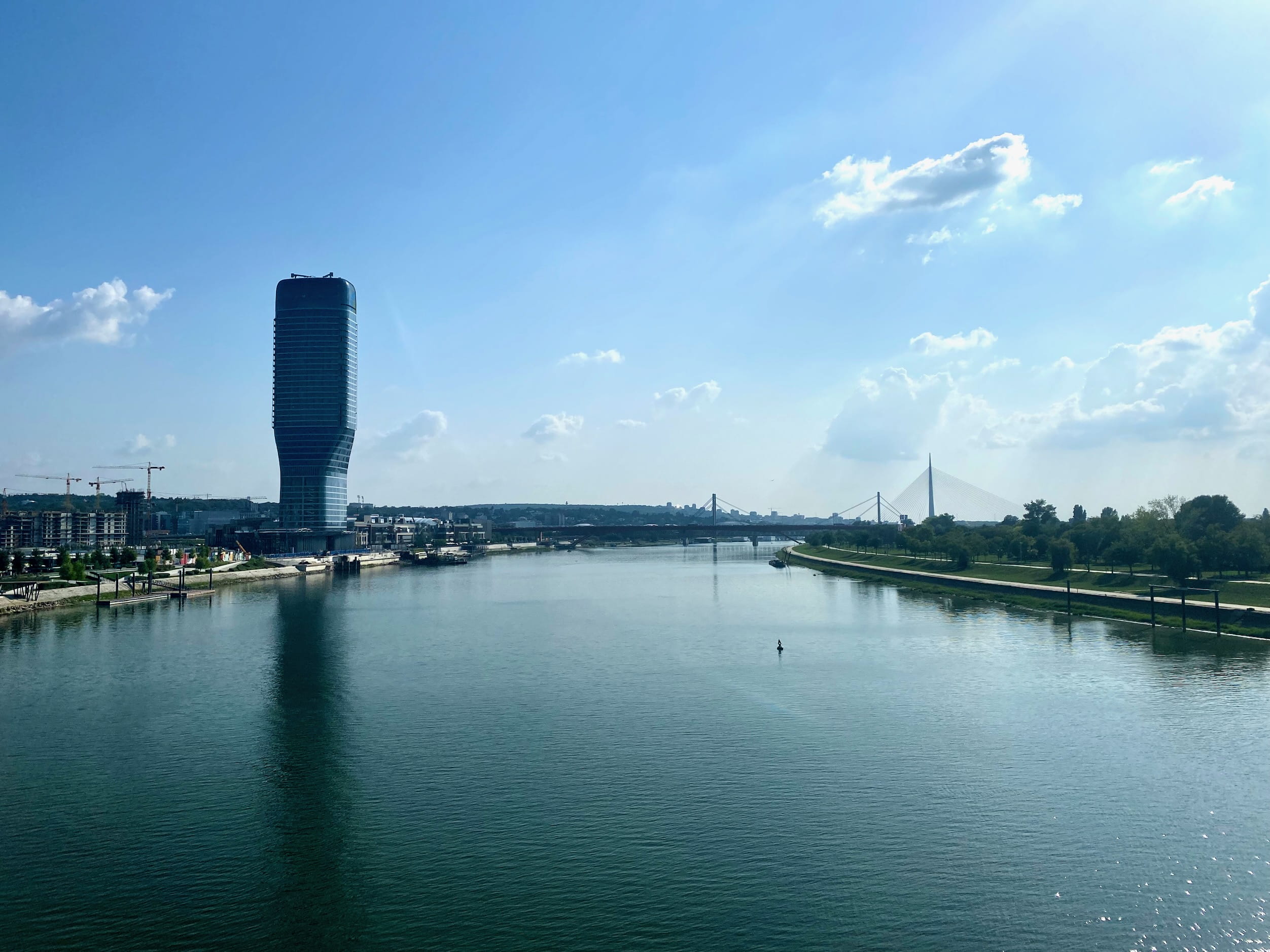
My favorite brutalist buildings are these multi-part complexes. So many modern structures are visually contained by a single shape: a twisty tower, a big egg, or an exploded pile of metal (lookin’ at you, Gehry). But behemoths here seem to be the result of gluing together great geometrical chunks. They strangely fascinate me.

Digraphia
Standard Serbian language uses both Cyrillic and Latin script. Serbian is a rare example of synchronic digraphia, a situation where all literate members of a society have two interchangeable writing systems available to them.
This. Is. So. Cool.
Everywhere, you see both Latin and Cyrillic. Billboards, store names, street signs, menus, information placards. I’d never been somewhere where Cyrillic is used, but this was a treat beyond my expectations: fluid use of two writing systems!
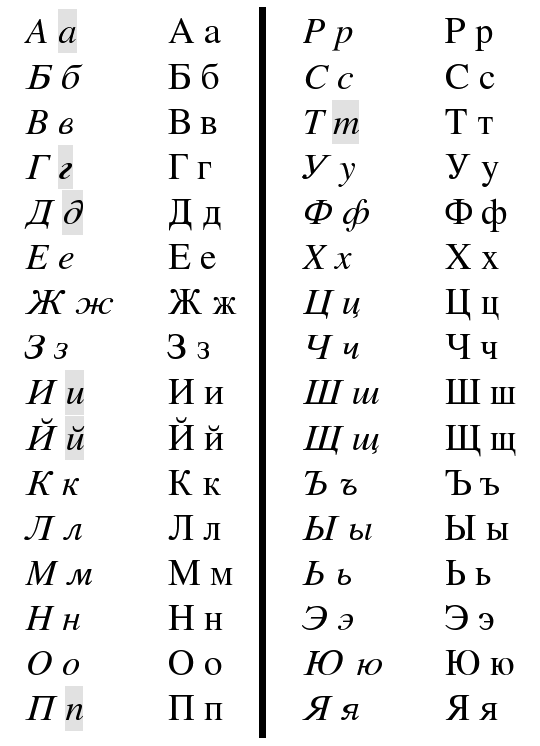
Cyrillic letters & italic variants.

Saint Sava Temple


Towering on the outside. Inside, a ceiling bursting with drawings and gold plating. But then… there’s all this empty space. Nobody’s using it for anything. And there’s this wall of construction, a big cord going across, random objects. And on the outside, scaffolding and piles of material.


It’s this half-orderly stuff that caught my eye. Fences that don’t quite reach anywhere, and people don’t really care about them. Many things functioning but unfinished. Rules a bit more like suggestions.

The park is kind of like, “fuck it, we’re tired of building, let’s just go.”
Outside, signs proudly feature Putin contributing a little piece to the building at an opening ceremony. This is a little indicator of what makes politics in this region so complex. Serbia is nearly alone in Europe in its long and deep allegiance with Russia, souring relations with its neighbors. Serbia, for example, was the only European country (besides Belarus, of course) that didn’t impose sanctions on Russia after they invaded Ukraine. And back when Serbia was clawing even harder at Kosovo in '07, Russia stonewalled all UN attempts to come up with a diplomatic solution. Etc ad nauseam.
Repair and Disrepair

“There are no puddles in Switzerland.”
So once proclaimed a Swiss friend. I had never thought about puddles before as a failing of infrastructure. But when he was visiting me in Seattle, he noticed them and told me.
Coming to Belgrade form London, I naturally observed:
- puddles
- people selling wares on top of their car hoods
- trash littered about
- concrete chunks strewn around
- abandoned buildings, smashed windows, graffiti
- abandoned construction, rebar sticking out of the first story of poured cement
- poles open with their wires visible
- buildings that have become rubble
- the rustiest street trams I had ever seen04
- bridges with jangling metal as trams passed on them
This triggered the start of my reflecting on the concept of repair. How repair is a permanent necessity for human-made environments. Everything must always be in a continuous state of repair, or fall into disrepair.

When you start noticing this stuff, it’s easy to hunt for the most destroyed buildings, the biggest ugliest commie blocks, the grossest pile of trash. Photograph those and tell one story with it.

Underground passageway

Some disarray is subtle, like the jets of this fountain exhibiting wildly different water pressure levels.
But the story of ruins and rubble isn’t true, of course. The truth is somewhere in the middle. Because at the same time, there were signs of newness and wealth:
- brand new gorgeous construction
- manicured lawns, flower beds, and art sprinkled about business parks
- Rolls Royce, Mercedes, etc.
Sometimes you would see both failed construction and newness in the same place. Belgrade’s train station is perpetually half-built, years overdue. Tracks plunge into a great concrete ceiling that has the vague hopes of a second story sticking out of it.

But the trains themselves are quite nice—the cars feel right out of Germany.

This inconsistency made me reflect on my total lack of understanding of how development takes place.
It’s easy to look down on somewhere when you’re from a richer place. Even though you had absolutely nothing to do with how it (your richer home) got that way.
But what would you do if you were in charge of a developing place? Do you worry about the trash and rubble and disrepair? Is that all a distraction to building new stuff? Generate the wealth first and launch clean ups later as you need to?
Yugoslav Ministry of Defense Building
My friend Bor had told me about this. “After the Americans bombed them in 1999, they just left this destroyed building right in the middle of the city.”

And so they had. The whole situation is messy. Yugoslavia was committing genocide against Albanians in Kosovo. NATO wasn’t supposed to stop them because Russia and China said no. But they went and bombed Serbia anyway.
Belgrade left the rubble long enough that it eventually became a “de facto war monument.”05
Serendipitously, what appears to be a gigantic military poster hangs on a wall across the street.
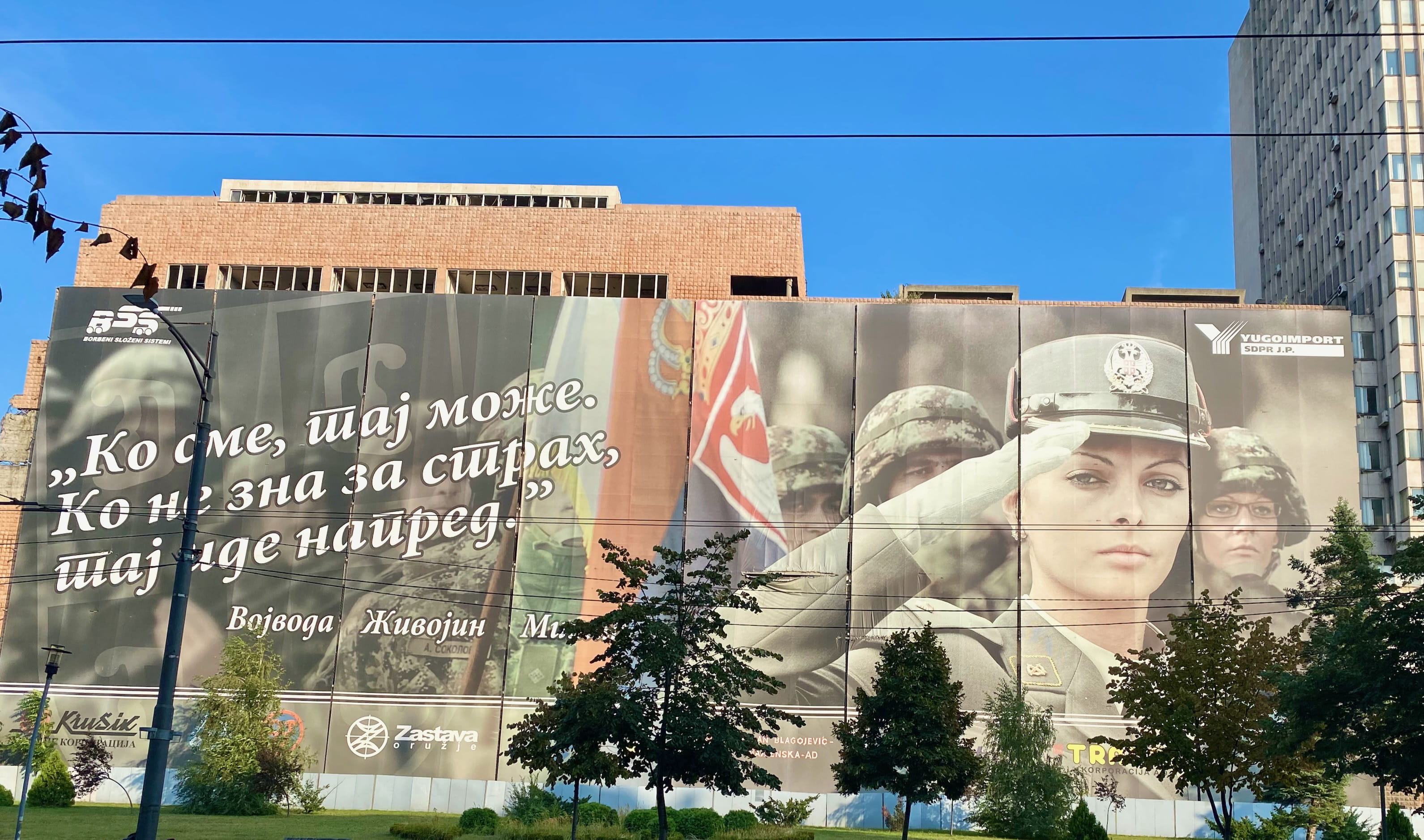
Climbing

It’s good to do something that locals do. Lets you peek into a slice of life, even just a little. For us, this is rock climbing. We seek out a local indoor bouldering gym wherever we can.
There was a little girl in the gym, running around while her Serbian dad trained. Eventually, she got bored and went to watch a movie in the locker room. The movie was in English. Reminded me of the media language effect:06 simply having a better education system doesn’t automatically correlate with better English skills. Because in places that produce lots of media in their own tongue (e.g., France, Japan), kids don’t have to grow up on foreign films and TV.07
New Belgrade: Brutalist Utopia
My favorite places to go are where locals would say, “why would you go there? There’s absolutely nothing to see.”
We took a long sweltering walk across the river to New Belgrade.

This is actually from the way back.
Buildings that felt supremely 80s/90s corporate. Rows and rows of—at last—hardcore commie blocks. All with seemingly 50% odds of being maintained.





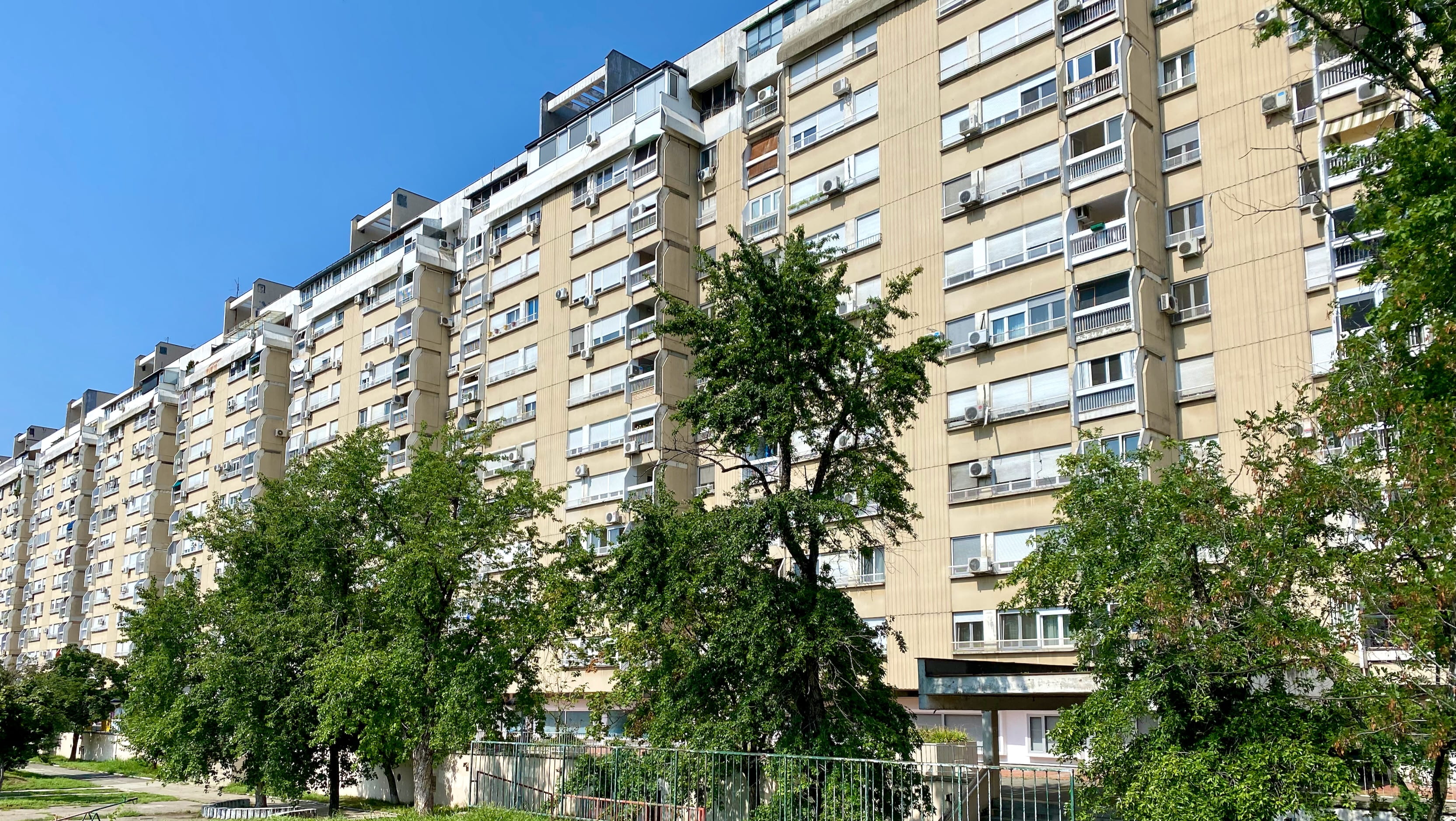
But the true star of the show was the Western City Gate.


This thing is so weird and unique and beautiful in the hopeless way only brutalism can achieve.


There were three ingredients that made it extra special. First, despite it being Belgrade’s most interesting building,08 we saw zero other tourists there during our whole visit.
Second, even though it’s still a functional apartment building, the area around it is all but destroyed.


And third, the lobby looks like vaporwave stock photo. It’s amazing.

We asked a guy inside whether we could go up to the restaurant at the top. He said no. (I don’t think it’s operational.)
Food and Drink
Not pictured, but we had the best ćevapi (grilled sausages w/ flat bread) to date in Belgrade. And that feast of a dinner cost under $2.50 each.
Visiting cocktail bars in new cities is fun. We encountered strong opinions and minimal herby potions in Ljubljana. The bar we visited in Belgrade was willing to build more elaborate rum-based tropical drinks.09 The best part of the place was the big framed picture of Tito—former beloved head of former beloved Yugoslavia.

Simple foods like börek and coffee were wonderfully cheap and delicious.

Belgrade did have the advantage of being the first Balkan place we visited in this travel segment. We’d grow desperate for vegetables over the coming weeks, subsisting entirely on grilled meat, baked cheese, and bread.

This is actually from Novi Sad. A cool restaurant called Plava Frajla proudly features the Vojvodina region, the north part of Serbia. Hearty food that seems to have Germanic influence. Their menu has plentiful asides telling you about the food history and culture.
Little Observations

“I can’t remember… let’s see, his last name ends with ‘vić.’ Is that helpful?”

Blatant knockoff of Victoria’s Secret?

“New Nork” really just slides off the tongue.

Have you ever seen a Coca Cola store before?

I hadn’t thought so much about regulation for a while. Like, limiting what people can do. (E.g., drive on grass and destroy it.) I have a hypothesis that, like many things, people are most comfortable with the amount of regulation in the place they grew up. (Destroyed grass also happens in the USA, especially in parks they’re setting up for a festival like this.)


Top: Left: Take a stroll down the lovely BLOK 66A, or perhaps the refined BLOK 28. Bottom: Right: There are some true gems in translated Google Maps reviews.
Novi Sad


We took a day trip to Novi Sad, Serbia’s second most populous city.
Novi Sad has a few churches, an unfinished bridge, and a sign that bafflingly declares it the European Capital of Culture.10

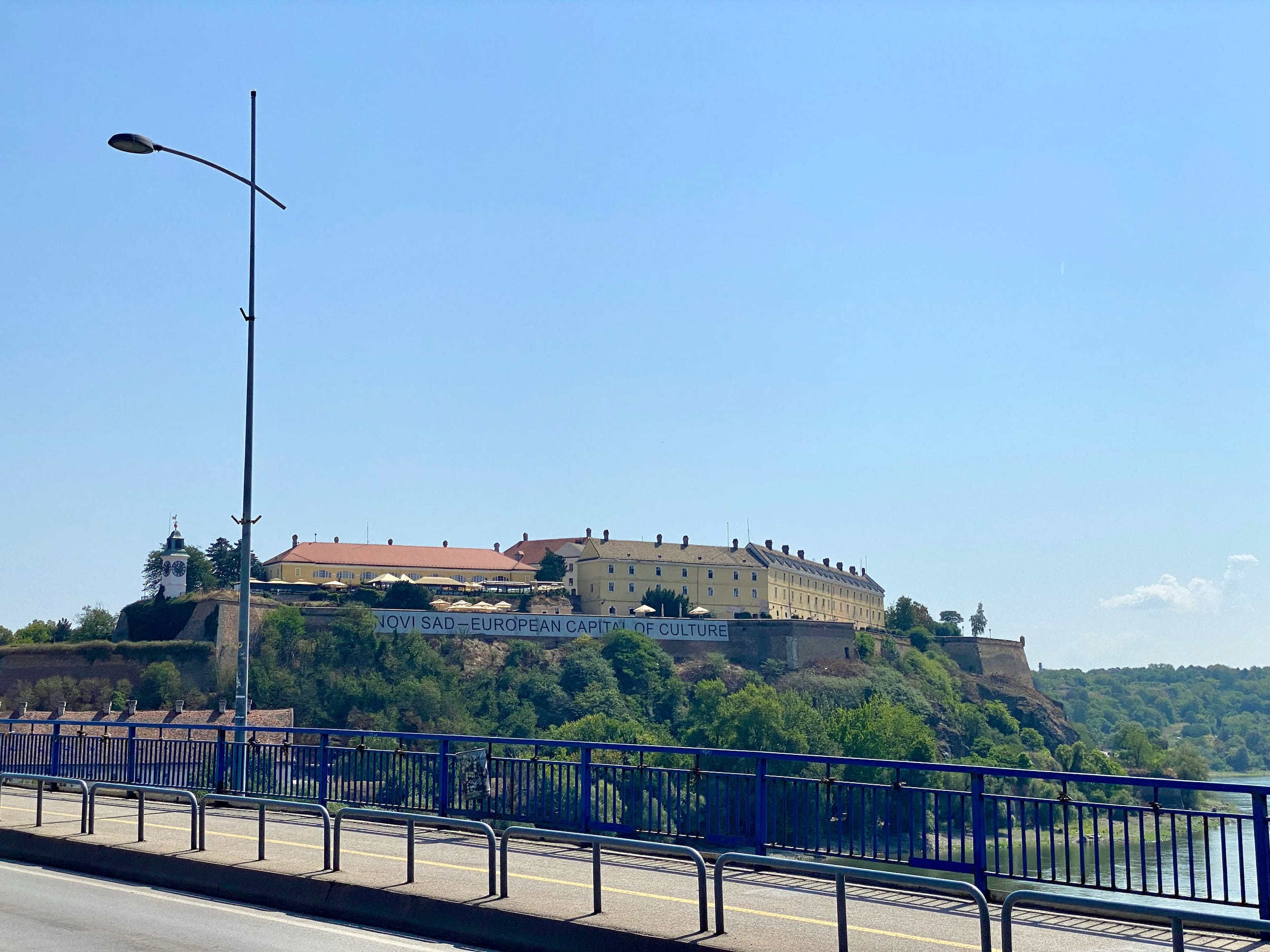


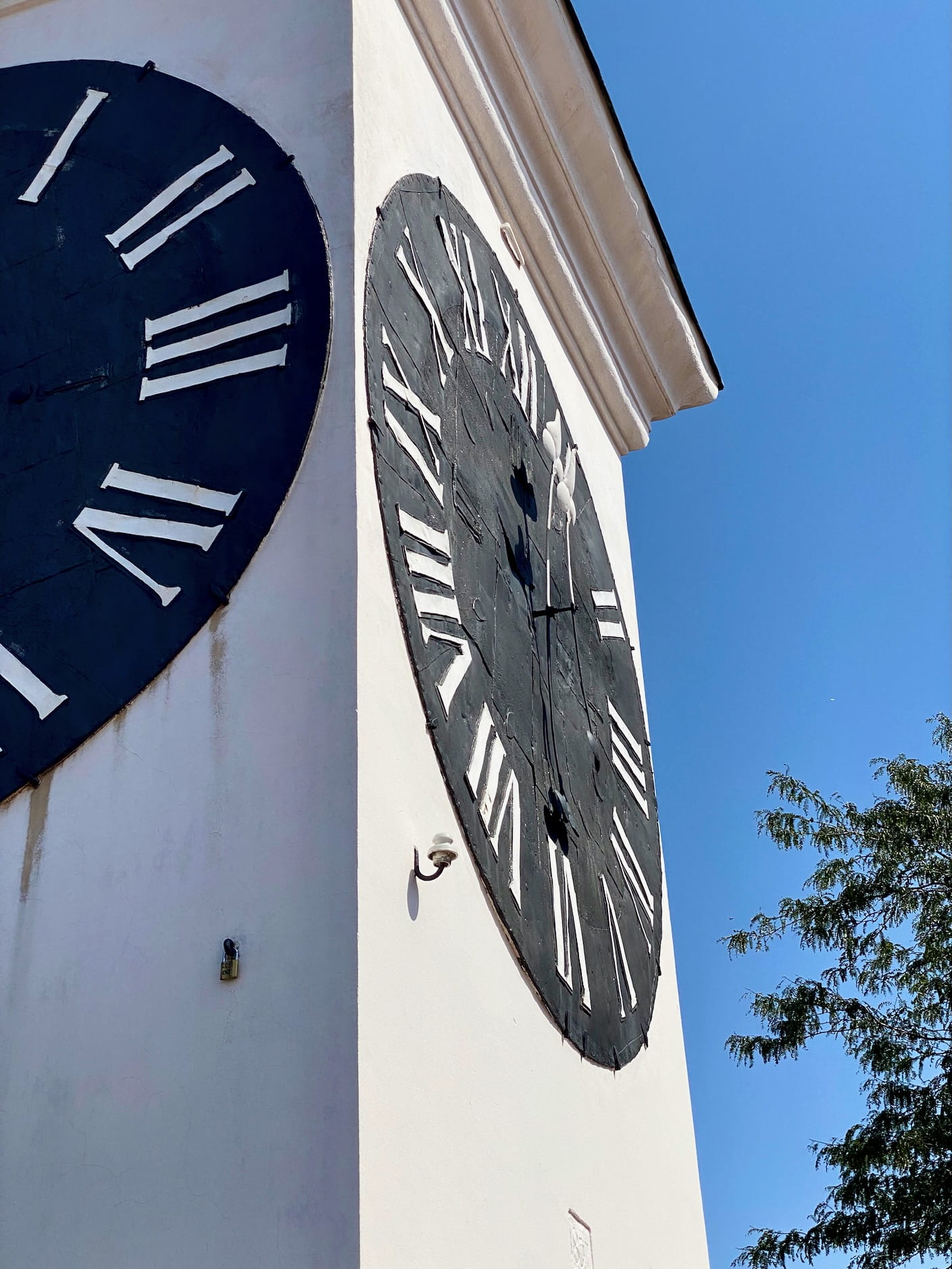





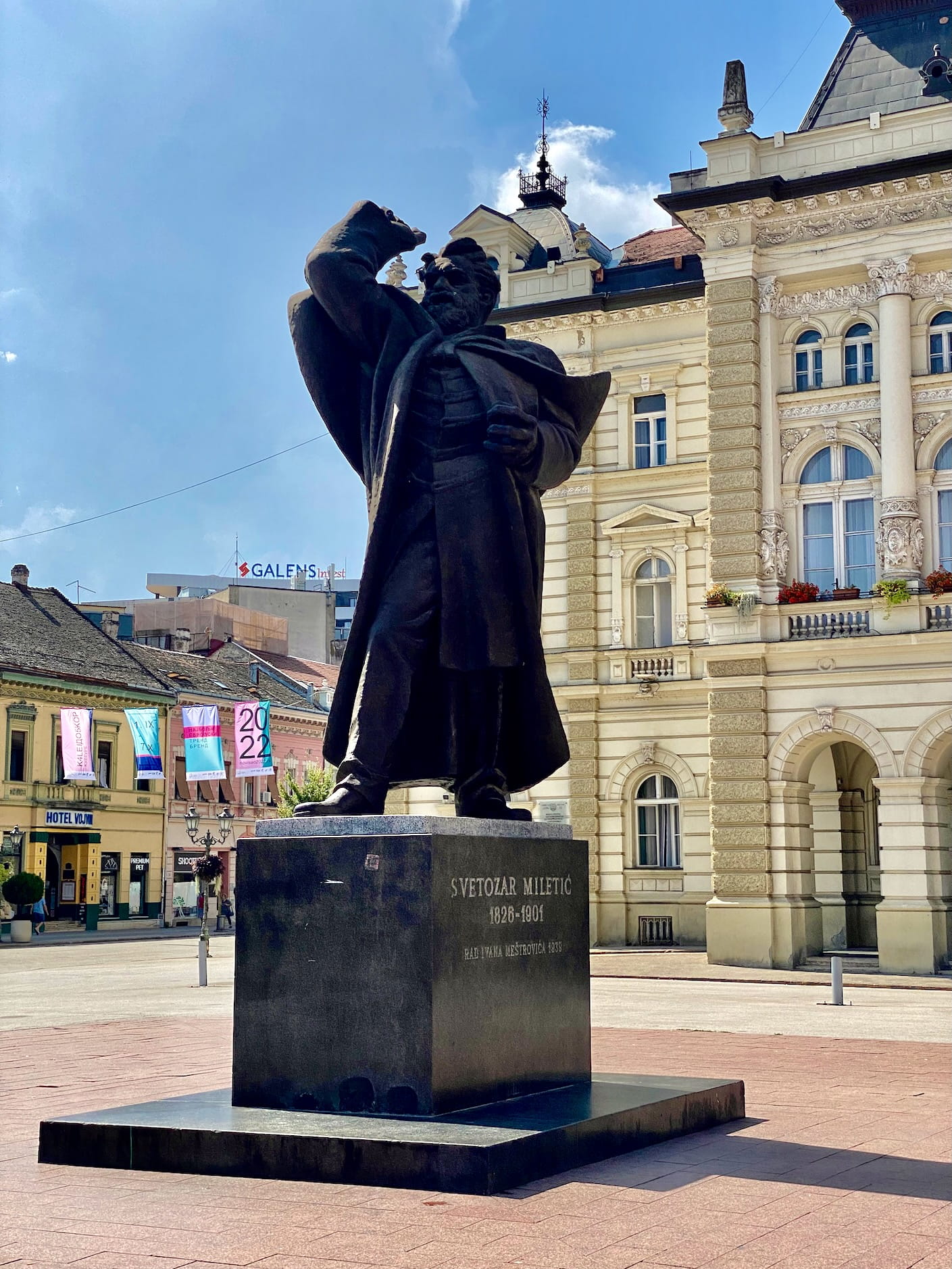
Shoutout to this statute of a guy poised to throw a ping pong ball into a solo cup.
The reason I included the photo of the park is it felt like the only lush greenery we’d seen all week. Fifty shades of concrete is no joke.
Sremski Karlovci

Took the train down from Novi Sad. We were the only ones who got off the train. We walked along concrete, grass, and dirt into town.
Strangely, we passed by a lot full of tour busses, drivers idling.

This is the kind of entertainment you get when you DIY somewhere. We’d eventually find the bus inhabitants in the form of British and German tour groups.
Setting into town, there were a handful of brightly painted buildings I obediently photographed.

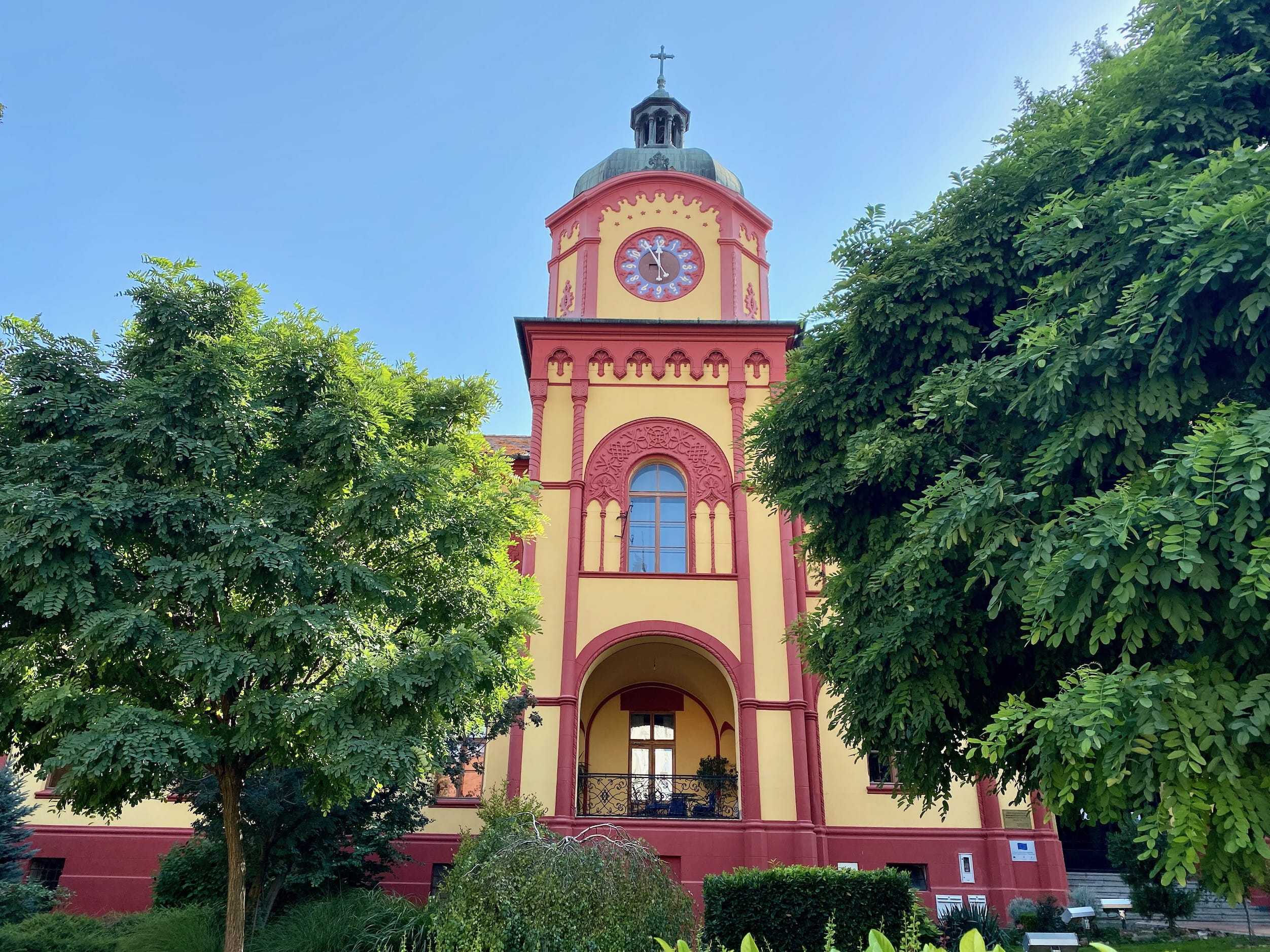


But we weren’t here for the buildings. This town’s fame is wine. It’s like the Napa Valley of Serbia, I guess.
We climbed up into the hills and barren roads of the town, seeking a place to pay for some local pours. But luck was not on our side.

Wandering from winery to winery, we were turned away at each one. We didn’t have a reservation. Hoards of senior citizens had mopped up all the slots. We seemed to be the only ones in the town who hadn’t arrived on a tour bus with a booking already set. It was hot, and we were running dangerously close to closing hour.
We finally wandered into Wine Cellar Petrovic (Подрум вина Петровић). Nobody else was there, and the owner—son of the founder—told us that it was because they were under renovation.
But then he said, hey, come check out the place. He showed us where they kept the vats of wine, poured us a few glasses of each. Talked about their processes, his family’s history. Gave us a tour of the new tasting rooms they were building. Asked us about where we were from.
After spending a good forty minutes with him, I tried to pay him when we said goodbye. He wouldn’t take anything.
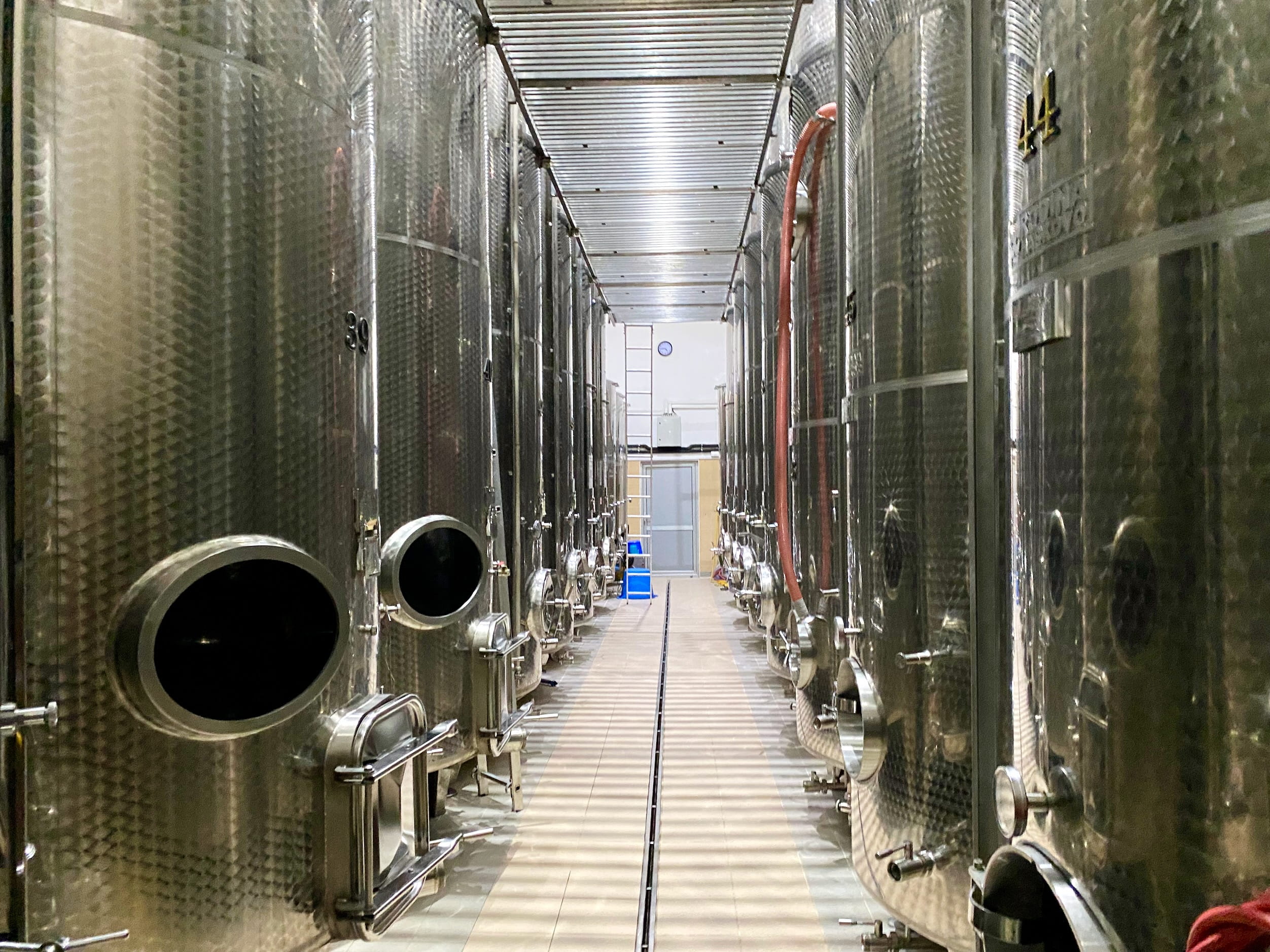
This was some serious generosity to two random foreigners who walk into your place. The least I can do is give them a plug: if you end up in Sremski Karlovci, check out Petrovic. Their remodel should be done by the time you visit. There’s no way he would remember us, but tell him thanks from two Americans to whom he showed touching hospitality warmth when they were hot and tired and wanted Cab. Sav.

One last thing. Got scammed by this damned vending machine waiting for the train to Belgrade. Parched, I put in about $10 to get change so I could buy a Pocari Sweat (Japanese Gatorade) from the machine next to it. Turns out the sign on it says it gives maximum $0.75 of change. The last thing I wanted while dehydrated at 6pm was twelve hot coffees. My only hope is that someone eventually came and drank all the free beverages I’d pumped it with.
To Bosnia

After a week in Serbia, we boarded a prop plane for Sarajevo.
Our final view of Belgrade summarized common landscapes of ex-Yugoslavia:
- great sectors of commie blocks
- … bordered by old homes with clay shingled roofs
- … all nestled in the bend of a tree-lined wide river.
Footnotes
Actually, that’s one thing traffic has in common with travel: waiting in lines when you don’t want to. The situations where you have to wait in a line are relatively rare in modern day. It seems like we get more easily upset in them. ↩︎
Why is it always taxis? ↩︎
This blistering name was given by https://wander-lush.org/, who I will now link in return for that wonderful noun phrase. ↩︎
Bosnia would immediately steal this prize. ↩︎
This thing I’m calling “the media language effect” may be a well-known thing in whatever field studies this (anthropology? linguistics?), or it may be I invented the idea and it’s actually totally false if you look at the data. Can’t remember, haven’t got the time to Google right now. ↩︎
Not claiming anything here about “everyone should learn English” or anything like that. Just an observation as a wandering monolingual idiot seeing who I can talk to. ↩︎
The Avala Tower could potentially take the cake for Belgrade’s coolest building, but it’s a 30-minute drive out of the city so I’m not counting it. That tower was featured in MoMA’s awesome exhibition, Toward a Concrete Utopia: Architecture in Yugoslavia, 1948–1980. ↩︎
The tiki drinks were uncreative and out of balance :-( Think twice before you get snobby about something. I mostly drink beer now. ↩︎
Novi Sad was one of the three European Capitals of Culture of 2022. On first glance, this award seems to have incomprehensible criteria. Paris won in '89 and it’s been downhill ever since. The Capital of Culture designation now goes annually to cities you’ve never heard of—the other two in 2022 were Veszprém (Hungary) and Timișoara (Romania). The purpose is to “foster urban regeneration” (quoth Wikipedia) rather than some kind of achievement. So, again, can’t dunk on it too hard. ↩︎